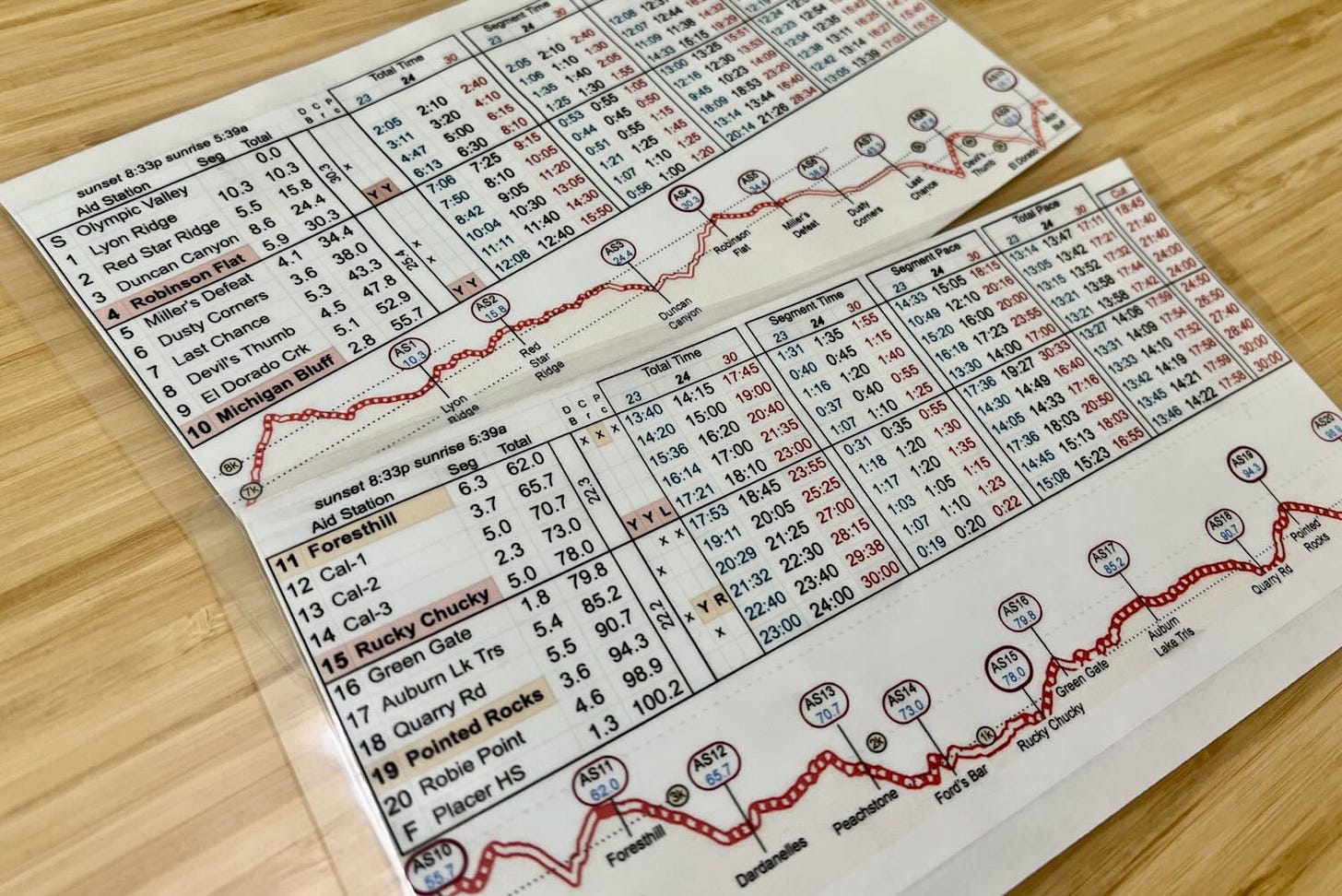Tapering to Race Day (Western States part 4)
Nothing dumb, focus and prepare, make it epic, and some Simple Rules
This is the fourth installment in a series about my upcoming Western States Endurance Run adventure. My intent is to give you a look behind the curtain, to maybe demystify this ultra thing, and show how fairly normal people go about doing big things. We each have our own approach, but I imagine every successful ultrarunner uses some version of a process something like this one. I also imagine there might be some lessons from this process that apply to other big endeavors — maybe even one of yours…
Tapering (phase 3)
The purpose of the taper is recovery — both mental and physical — from the hard training of the past 4 months or so. It’s a period to lock in gains and prepare for race day.
From part 1:
Tapering is an act of faith, and this is a time when wisdom must overcome ambition. There will be a strong urge to get in just one more big week, just one more big climbing day, but at this point, the potential benefits of more hard training are tiny, and the potential for harm is high. A good phase-III mantra? “Don’t do anything dumb”
Nothing dumb
That means: nothing to compromise the hard work that got me this far. No cramming, no crafty new speed workouts, no heroics. As tempting as it may be (I’m at peak fitness), this is not the time for PR segments, not the time for running fast on the rocks, not the time for anything that doesn’t center on caution and patience and restraint.
It’s also not the time to give in to dietary urges and splurges, or to slack off on the stretching routine or to get bad sleep, or to be sloppy with the tick checks (doxycycline is not a PED).
It’s a time to withdraw, to become monk-like and limit exposures — to stressors and distractions, to crowded spaces and diseased air, to anything that might cause me to break focus (tapering is NOT a vacation).
It’s been a good flight so far — now it’s time to land this thing.
Focus and prepare
To maintain focus, it helps to have some specific tasks and targets. I group these into four piles:
1. Physical Refinement
The guiding principle for physical training during the taper is “decrease volume, maintain intensity” — the high-mileage, big-climb weeks are over. A wise move is to redirect that running time towards your stretching (the same old routine, but slower, deeper, more relaxed, more luxuriant) and proprioception drills.
If you’re racing somewhere that’s potentially warm (I am) this is also the time for intensive heat training. For me, this is a 10-day period when nearly every run is IOD (intentionally overdressed: many layers, winter hats and hoods, etc.), at the warmest time of day, and followed by sauna time. It is a glorious sweat-fest that triggers your body to sweat well, retain electrolytes, and teaches it to love (or at least tolerate) the heat.
[As I was starting my heat training, I had a long conversation with ChatGPT about it. She was verbose and disclamatory, but also helpful (and it has jokes and haikus!)… you can read our discussion here.]
This is also a good time to work in some NRA “runs”: No Running Allowed… unless you’re elite (and probably even then), walking is a vital — but likely undervalued and undertrained — part of 100-mile success. And there’s a big difference (like 2 or 3 minutes/mile) between just walking and Walking-With-a-Purpose. It’s worth practicing.
2. Tactical Planning
For me, tactical planning is one of the best parts of this game. I talked in detail about how I do that here:
Quoting from that article:
A hundred miles is too much for me to comprehend as a whole. To take it on, I have to simplify it, create a metaphorical representation of it that specifically leaves out many details, while drawing out other details that I might not otherwise see.
3. Logistical Preparation
This part is pretty straightforward, but the details count. Choose your gear and supplies, make sure you have it all on-hand (inventory and order well ahead of time), make sure it all works and everything is charged, decide where it goes (on your body, in your pack, or in a drop bag or crew bag), and then pack it all up.
Simple is better, lighter is faster, but consider contingencies and worst-case scenarios.
And then check it, and double check it, and check it again.
4. Mental Readiness
Working the details of those first three — the physical, the tactical, and the logistical — and knowing that I have them right, is the biggest key to mental readiness for me. But I augment that with a couple things…
I make it feel epic
This is an act of positive self-deception. The upcoming challenge and the hardships are voluntary, and there’s almost always a safe and easy way out — you just have to stop. But deep in our sheltered modern souls we want that not to be so. We crave true tests and epic situations, and one of the main reasons we run these races is to simulate that for ourselves.
But for that to work, we must nurture the illusion. So now is not the time to equivocate, to say to ourselves that this doesn’t really matter. Of course it doesn’t matter, but that doesn’t mean that it isn’t very, very, important.
I add music
Loading my (mental) jukebox is one way I keep it epic. I build a playlist of epic-feeling music (music that helps put me in touch with “the rush of it all”). I listen to it while I do those long stretch sessions, while I pack my bags, while I’m on that flight. I lodge it firmly in my mind, and then, at key moments, I can turn it on to help me up that climb, or to magnify the impact of the view from the top.
If you’re curious, here’s my WSER 2023 playlist.
Get There (phase 4)
Race Week is also Transcontinental Travel Week, with all the stress and joy that comes with that.
Best be ready ahead of time, leave some margins, some cushion. And then — just go with the flow.
This is where I’m at now…. and somehow I’ve managed to get everything ready and packed. In fact, other than one more little trot through the gamelands, this post is all I have left to do. Tomorrow morning we enter the air travel system, and hopefully it will spit us out in Reno tomorrow afternoon, and then it’s on to Olympic Valley and Western States.
Race Day (phase 5)
24 hours of patient, focused intensity, as the culmination of 25 weeks of focused effort, after 25 years of sustained practice…
Yes, of course it’s about the journey, and it’s about the practice, and of course that is more important than this or any particular race, and the results of this race will not make or break anything about those 25 years (or what follows).
But…
…for at least one day it is about this race. It’s about submerging into the single-minded focus of the race, dealing with whatever may happen, solving problems, pushing, getting the very best from myself.
So I’ll focus. I’ll start slow and be steady and take the long view, I’ll trust my crew and my pacers and my fellow runners, I’ll enjoy the mountains and the day (but as a partner, not as a tourist), I’ll follow my Simple Rules…
…and soon enough, we’ll see how it goes.
Some Simple Rules for Ultras
- You planned your race, now race your plan (but also: flexibility is the key)
- Go fast, but never hurry
- Mind the transitions (never run from a standing start, never stop abruptly, careful at all crossings and peaks and bottoms)
- Drink to thirst (but do it every 20 minutes)
- Patience (it's a long race)
- Most of all: Pay Attention!To follow the action on race day, try one of these links (I’m #389):
Live broadcast (YouTube) from the Western States folks
Live splits/results from Ultralive
iRunFar’s Western States coverage
Need to catch up? Here are parts 1-3 of my Western States adventure:











This is very awesome! Loved the whole series on WSER. Thanks for sharing!
Enjoy! I’ll be along for the ride.